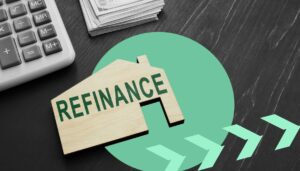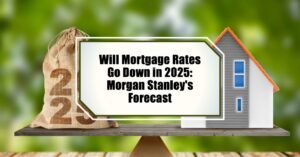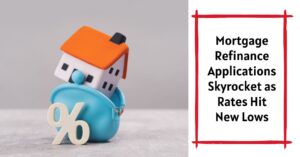If you're thinking about making a change to your home loan in 2025, you might be scratching your head trying to figure out why the interest rate for refinancing your current mortgage seems a bit higher than what’s advertised for buying a new home. It’s a common observation, and typically, you'll see refinance rates nudge a little above purchase mortgage rates – maybe around 0.1% to 0.3% higher. This might not sound like much on paper, but over the life of a loan, it can add up. I’ve spent a lot of time digging into this, and I can tell you there are some solid reasons behind this, and understanding them is key to making smart financial decisions.
Why Are Refinance Rates Higher Than Mortgage Rates in 2025?
The Simple Answer: It's All About Risk (and a Little Bit of Lender Economics)
In a nutshell, lenders often view refinancing a mortgage as inherently riskier than providing a new loan for a home purchase. This perception of higher risk leads them to price refinance loans with a slightly higher interest rate. While the exact numbers can fluctuate, as of early October 2025, we're seeing average 30-year fixed purchase mortgage rates around 6.34% (according to Freddie Mac), while refinance rates for the same term are hovering between 6.47% and 6.65%. This difference, while seemingly small, is what we’re going to explore in detail.
Diving Deeper: What's Really Going On with These Rates?
Let’s break down what makes these rates different. It’s not usually a case of lenders trying to pull a fast one; it's more about how they assess risk and manage their business.
1. The “Riskier Borrower” Factor: Why Lenders Sweat More on Refis
Imagine a lender looking at two scenarios.
- Scenario A: The Home Purchase. A buyer is excited, has a contract on a house, and there are other parties involved – sellers, real estate agents, and potentially moving vans scheduled! There's a real sense of urgency and a whole lot of momentum to get that deal closed. The lender sees this as a pretty straightforward transaction.
- Scenario B: The Refinance. You're looking at changing your existing loan. Maybe you’re looking to get a better rate, or perhaps you want to tap into your home's equity for some home improvement projects or to pay off other debts. This can sometimes signal to a lender that a borrower might be stretching their finances a bit thin, or that they’re comparing offers aggressively. Statistically, homeowners who refinance, especially those taking out cash, can sometimes show a slightly higher tendency to run into trouble later on if their financial situation changes. Lenders build this “what if” into the rate.
From my experience, when people are cashing out equity, it’s not always for frivolous things. It can be to consolidate high-interest credit card debt or to make essential home repairs. But from a lender's pure statistical perspective, pulling more money out of a home adds to the overall debt load, and that’s seen as a potential red flag.
2. The “Shopping Around” Phenomenon: The Lender's Cost of Uncertainty
This is a big one. When you're buying a home, you're on a bit of a deadline. You lock in a rate, and you tend to stick with that lender to get the deal done. When you're refinancing, however, you have more flexibility. You might shop around at several different banks and mortgage companies, perhaps locking in rates with a few before deciding which one is best.
For lenders, this “rate shopping” means they spend time and resources processing your application, getting your credit checked, and preparing the loan documents – all for potentially no return. It's what the industry calls “loan fallout,” and it's higher with refinances. To cover these costs and the risk that a borrower will simply walk away to a competitor offering a slightly better deal, lenders sometimes add that small premium to the refinance rate. It’s a way to ensure they’re not losing money on the deals that don’t go through.
I’ve seen many clients get caught in this. They’ll shop multiple lenders looking for a quarter-point better rate, and while that’s smart financially, it adds up in terms of the lender’s operational expense.
3. Market Dynamics and Economic Headwinds
Beyond these borrower-specific factors, broader economic conditions also play a role. In 2025, we’re still seeing the ripple effects of economic adjustments. Even with the Federal Reserve making some rate adjustments, there’s a general sense of cautious optimism mixed with uncertainty.
- Inflation Worries: If inflation is a nagging concern, lenders might be more hesitant to offer their absolute rock-bottom rates on loans that will be held for many years to come. Refinances, which extend your financial commitment, might get treated with extra conservatism.
- Fed Policy Nuances: While Federal Reserve rate cuts are generally good news for borrowers, the effect on mortgage rates isn’t always immediate or uniform. The actual mortgage rates are tied more closely to Treasury yields, and the spread between purchase and refinance rates can persist because lenders are already factoring in those perceived risks of refinances.
Think of it like this: the Federal Reserve sets the general direction, but each lender has its own internal compass, and that compass on refinances often points to a slightly higher destination due to perceived risk.
4. The “Rate Lock-In” Effect and Borrower Profile
It’s also worth noting that your personal financial health heavily influences your rates.
- Credit Score: If you have an excellent credit score – say, above 760 – the difference between your purchase and refinance rate might be negligible. Lenders are more confident lending to borrowers with a proven track record of financial responsibility.
- Loan-to-Value (LTV) Ratio: How much equity you have in your home matters too. Households with more equity (lower LTV) are generally seen as lower risk.
- Cash-Out vs. Rate-and-Term: Refinances that involve taking out cash (cash-out refinances) are almost always viewed as riskier than those simply aimed at lowering your interest rate (rate-and-term refinances).
A Look Back: How We Got Here (and Why It Persists)
To truly understand why this happens, a little historical context is useful. Mortgage rates have been on a rollercoaster, especially in the last five years. We went from historic lows below 3% in 2020-2021 – which triggered a massive refinance boom where people were saving loads of money – to soaring rates above 7% in 2022-2023 as inflation spiked.
By 2025, rates have settled down into the mid-6% range, which is much more manageable than the 2022-2023 peak. However, many homeowners are still benefiting from those sub-4% rates. This has suppressed refinance demand because why would you trade a 3% rate for a 6.5% rate? For those who did lock in rates in the high rates of 2022 or 2023 and are now looking to refinance to a lower rate, those borrowers are the ones who might face that slight premium. The market is still adjusting, and lenders are being cautious.
| Year | Average 30-Year Fixed Purchase Rate (approx.) | Average 30-Year Fixed Refinance Rate (approx.) | Key Observation |
|---|---|---|---|
| 2020 | ~3.0% | ~3.1% | Record lows, huge refi boom |
| 2021 | ~2.9% | ~3.0% | Still very low, continued refi activity |
| 2022 | ~5.5% | ~5.7% | Rates rise, refi demand drops, gap widens a bit |
| 2023 | ~6.9% | ~7.1% | High rates, significant refi premium |
| 2024 | ~6.7% | ~6.9% | Stabilization, premium persists |
| 2025 (Early Oct) | ~6.34% | ~6.5% – 6.7% | Lower overall rates, but refi premium remains |
This table shows a pattern where the refinance rate often trails slightly above the purchase rate, especially as overall rates begin to normalize or rise.
Forecasting the Future: Will This Gap Close?
Looking ahead, most experts predict that mortgage rates will continue to stabilize in the mid-6% range throughout the rest of 2025, and perhaps even dip slightly if the Federal Reserve continues its easing policy. However, will the refinance premium disappear? It’s less likely. The underlying reasons – risk assessment and operational costs for lenders – are pretty sticky.
What could make the gap smaller?
- A significantly stronger economy: If unemployment stays low and more homes come onto the market, increasing overall demand for mortgages, lenders might compete more aggressively on refi rates.
- Increased competition: If more lenders decide they want a bigger piece of the refinance market, they might shrink that premium to attract borrowers.
But for now, it’s reasonable to expect that a slight premium on refinance rates will likely continue.
So, Should You Even Bother Refinancing in 2025?
Absolutely! Don't let that small premium dissuade you entirely. Even with a slightly higher rate, refinancing can still be a fantastic move, especially if your current mortgage rate is significantly higher.
When it still makes sense:
- You have a high current rate: If you have a mortgage from the 2022-2023 peak era with a rate of 7% or higher, even a 6.5% refinance rate represents significant savings.
- You plan to stay put: A crucial calculation is the “break-even point.” This is how long it takes for the money you save on monthly payments to recoup the closing costs of the refinance. If you plan to stay in your home for longer than your break-even period (often 2-3 years), it's usually worthwhile.
- You need cash: Cash-out refinances are still a popular way to fund home renovations, consolidate debt, or cover other major expenses. Just be aware that this type of refinance might carry the highest premium.
Recommended Read:
Alternatives to Consider if Refinancing Feels Like Too Much Hassle
If the higher rates and closing costs seem daunting, or if your current rate is already quite good (like below 5%), there are other options to explore:
- Home Equity Loan or HELOC: If you only need a portion of your home's equity, a home equity loan (a lump sum with a fixed rate) or a home equity line of credit (HELOC – a revolving line of credit with a variable rate) might be more cost-effective than a full refinance.
- Loan Modification: Sometimes, you can negotiate directly with your current lender to change the terms of your loan without going through a full refinancing process. This is less common but worth asking about.
- Assumable Mortgages: On certain types of loans (like some FHA or VA loans), you can “assume” the seller's existing mortgage, sometimes allowing you to take over their lower interest rate. This is less common for general homeowners but can be a huge advantage when available.
- Wait and See: If you have a good rate now (e.g., below 4.5%), and your primary goal is to lower your payment, you might decide to wait and see if rates drop significantly in 2026 or beyond.
The Bottom Line: Knowledge is Your Best Tool
Navigating mortgage rates can feel like a complex puzzle. While it’s true that refinance rates are often a tad higher than purchase rates in 2025, this doesn't mean you should dismiss the idea of refinancing altogether. It’s a calculated decision. The premium exists due to how lenders assess risk and manage their operations. By understanding these factors – the borrower's financial situation, the lender's costs, and the broader economic climate – you can make an informed choice.
My advice? Always do your homework. Get quotes from at least three different lenders, understand all the fees involved, and crunch the numbers to find your personal break-even point. What seems like a small difference in rates can lead to substantial savings over time.
Maximize Your Mortgage Decisions
Thinking about whether to refinance now? Timing is critical, and having the right strategy can save you thousands over the life of your loan.
Norada's team can guide you through current market dynamics and help you position your investments wisely—whether you're looking to reduce rates, pull out equity, or expand your portfolio.
HOT NEW LISTINGS JUST ADDED!
Talk to a Norada investment counselor today (No Obligation):
(800) 611-3060
Recommended Read:
- When You Refinance a Mortgage Do the 30 Years Start Over?
- Should You Refinance as Mortgage Rates Reach Lowest Level in Over a Year?
- NAR Predicts 6% Mortgage Rates in 2025 Will Boost Housing Market
- Mortgage Rates Predictions for 2025: Expert Forecast
- Half of Recent Home Buyers Got Mortgage Rates Below 5%
- Mortgage Rates Need to Drop by 2% Before Buying Spree Begins
- Will Mortgage Rates Ever Be 3% Again: Future Outlook
- Mortgage Rates Predictions for Next 2 Years
- Mortgage Rate Predictions for Next 5 Years
- Mortgage Rate Predictions for 2025: Expert Forecast





